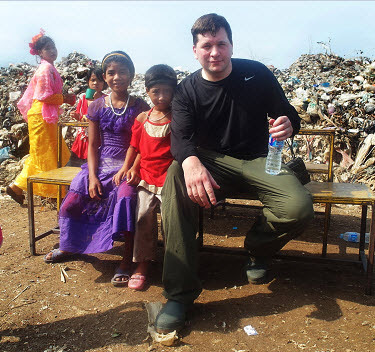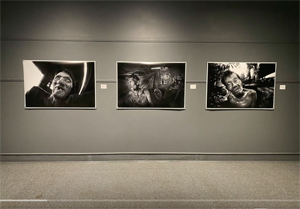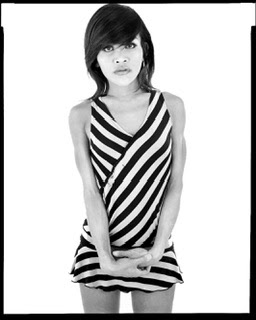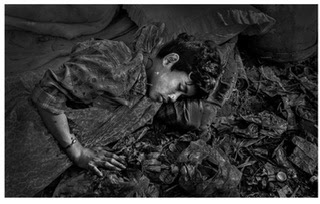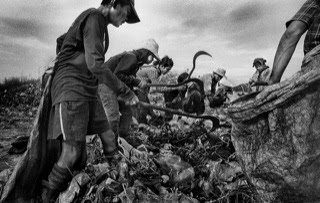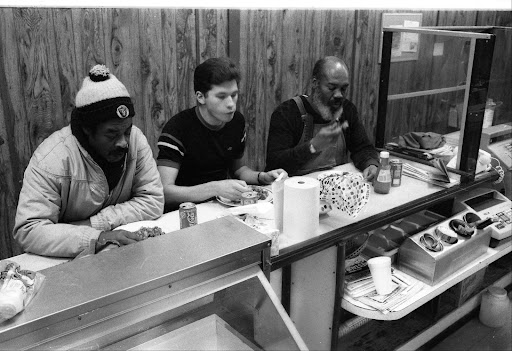National Post
Thursday, March 27, 2008
Humans have some of the most highly developed eyes in the animal kingdom, able to perceive colour, depth and speed with a split-second glance. But that doesn't mean that we perceive everything around us accurately. Far from it. As a new Toronto exhibit by German photographer Grit Schwerdtfeger shows, habit, familiarity and closeness can make us blind to uniqueness alongside the everyday. Here, Schwerdtfeger tells Leah Sandals why she holds distance, and its perceptive effects, close to her creative heart.
Q You work solely in photography. Why do you like it so much?
A That's a seemingly basic question, but the answer but is not so easy. I guess I like to see all the things and people around me. I'm a looker, a viewer. When I was a kid I painted, but never got serious, because if you're a painter you have to create and arrange a landscape or situation. I prefer to find them.
Q Where did you find these photographs, then?
A I don't like to talk about specific places. But I did all these pictures in Spain and Canada. And you can't see that it's Canada or Spain, necessarily, because I am looking for general places ?places that are open so that you can go into the pictures and imagine it could be anywhere.
Q It does seem that these places are all tourist-type locales, though.
A Yes, I'm looking for places where people spend their leisure time, and also places where people have constructed something in the landscape so it's not a really "natural" nature there. In Wiede, where all the people and cows are together, the cows were all put there as a tourist attraction.
Q Do you have a favourite picture?
A I really like Plattform because I really like what the people are doing in it. And it seems like it could be a picture from the Bible, with the men under the platform being like the Madonna. It's an ordinary situation but there are surrealistic things in it.
Q You are often far away from people in these images. Why?
A I always look from a distance to find my pictures. The last time I took a close-up was probably 10 or 15 years ago. Basically, I need to have distance from my daily life to make pictures. So I never do pictures in my city. If you are far away, somewhere you don't exactly know, you can see things better than at home. At home you're almost too close; if you want to see more you have to step back.
Q Does this mean you travel a lot?
A I don't like to say "travel," because if I take photos I have to stay somewhere a long time. I was in the north of Spain for three months. And I need this long a time to see pictures that are not a snapshot. Then when I go home I need six months or more to finish my work: it takes time to make my first-draft pictures and spend time with those, too. I have to feel that they are not only a "first look" picture, that they will be good after days and weeks.
Q That's such a difference from digital photography, where you can see a picture right away and decide whether to delete it or not.
A Yes, I could never take my art pictures digitally. It could be great for somebody else, but not me. I take my pictures analog and I print my pictures by hand. That's my kind of taking pictures. For family and jobs I make digital pictures. But for my artwork I really need analog.
Q What are you working on now?
A Recently I spent the first time in seven years away from my little boys. It was for one month on a small island in the north of Germany. It's a very popular island for holidays. And it looks really natural, but they have to do a lot so that the island looks natural. For example, the sea takes away all the sand on the beach and they often have to put back the sand to make it like a paradise. It was a great experience; I feel this island was really made for me.
Grit Schwerdtfeger: Distanz 2006 continues to April 27 at Corkin Gallery in Toronto. For information visitwww.corkingallery.com.
http://www.corkingallery.com/?q=node/127
skip to main |
skip to sidebar
I have been thinking of why I love photography, it comes down to something I have labeled "The Three Joys"
1) Creativity
The first joy is simply creating the work. Everything about the making of photographs I love. The initial ideas, the writing on the blog, the preparation of equipment, the research into my subjects, figuring out what I want to communicate. The camera tech stuff like composition, lens selection, cameras, figuring exposure, taking the shot etc. The post darkroom work where you swim with your prints bringing them slowly to life, creating something powerful and beautiful. I love it all.
It is so powerful a thing, you have a idea in your mind, there is nothing else, then YOU make it, you create it, it's fricking awesome stuff.
2) The People
The second joy is that photography has allowed me a way into so many peoples lives, so many different worlds. I get to meet people of all types, speak to them, eat with them, cry and laugh with them. For a while I get to live their existence to be them if you will.
I get to be a child in a slum in Bangkok or a drug addict in a ghetto in Oakland. I get to be a ladyboy sex worker in Pattaya or a man dying of cancer in Canada. Of course I am not really those people but I get a true flavor for those worlds, those experiences, the good and the bad, the ugly and the beautiful, the joy and the sadness.
With photography I get a chance to live outside of the same same everyday meat and potato lives many of my friends and family live. Because I use a camera and make pictures all the doors to a wonderful life experience are open to me, photography is a window into everything!
3) The Photograph
The third joy is about the feeling you get when you accomplish your goals, when you see your final print in the developer, fix or hanging in a gallery. There is a special emotion there, a true satisfied happiness, something so uniquely rewarding. In the darkroom sometimes when I see the finished photo for the first time as it lays in the fixer tray I will let out hoops of joy. I will scream and shout. It is quite a spectacle! It's just the sheer high of that moment bursting out, the YES moment. When the photo is right and you see it for the first time it's the best feeling in the world, better than anything I have ever felt, the high of highs!!
"Ain't Photography Grand!"
Contact Gerry Yaum
contact@gerryyaum.net
"Black & White" Photography Magazine, Issue #160
Search This Blog
Me, W. Eugene Smith, Sebastiao Salgado, Lewis Hine and Walker Evans! :) NOT!!!
LUNCHBOX Radio Interview FOR UNB EXHIBITIONS
MONEY EARNED TO HELP THE PEOPLE IN THE PICTURES
Money that will be used to directly help the people in our two photography projects, THE FAMILIES OF THE DUM and THE PEOPLE WHO LIVE UNDER THE FREEWAY $6334.67 ($6000 earned when 6 prints were added to the UNB permanent collection).
GOFUNDME, FAMILES/FREEWAY
Trying to raise $2000 to help the people under the freeway, and the families of the dump. TOTAL RAISED SO FAR = $325 —->$314.67 (after GOFUNDME fees).
UNIVERSITY OF NEW BRUNSWICK EXHIBITIONS VIDEO
Analog Forever Magazine
Vernon Morning Star Newspaper Story
2022 "Families of the Dump"/The People Who Live Under The Freeway Donation Buys
Total donation money spent for the 2022 trip to the Mae Sot dump (THE FAMILIES OF THE DUMP), Bangkok's Klong Toey Slum (THE PEOPLE WHO LIVE UNDER THE FREEWAY). Money spent on "The Families of the Dump" = $571.17 CAD (14982 Thai Baht) Money spent on "The People Who Live Under The Freeway = $144 CAD (3849 Thai Baht) General cases where money was spent to help others in need $15 CAD (401baht)
(Thai Currency) or
CAD
"Families of the Dump" Donation Total
$4420.02 CAD
GERRY YAUM: YouTube Video PHOTOGRAPHY CHANNEL
THE GOAL
To create photographs that speak to the universality, the commonality and the shared humanity of all peoples, regardless of country, race, culture or language.
TRANSLATE YAUM'S PHOTO DIARY INTO YOUR LANGUAGE
Quote: Robert F. Kennedy
“The purpose of life is to contribute in some way to making things better.”
Quote: Nelson Mandela
"As long as poverty, injustice and gross inequality persist in our world, none of us can truly rest."
Quote: Weegee (Authur Fellig)
"Be original and develop your own style, but don't forget above anything and everything else...be human...think...feel. When you find yourself beginning to feel a bond between yourself and the people you photograph, when you laugh and cry with their laughter and tears, you will know your on the right track....Good luck."
Blog Archive
-
▼
2008
(236)
-
▼
March
(32)
- Eight Solos Top Ten List
- Fascinating Book: Image Makers Image Takers
- All Sex Worker 8x10 Film Developed
- Dith Pran an Inspirational Person Dies
- Eight Solos Matting Technique
- Review: Eight Solos Part 5
- Review: Eight Solos Part 4
- Review: Eight Solos Part 3
- Review: Eight Solos Part 2
- Review: Eight Solos Opening Thoughts
- A Fun Day
- The Dangers of Conforming
- Insight From Afar
- 3 Hearts
- Up Close: a Review
- Critiques Why We Should Not Be Afraid
- Philip Jones Griffiths Died Today
- Lawsuit Threatened
- Art Museums - Collecting Photography
- Mono Guild Article
- Gallery Censorship
- Review of Monochrome Guild Photographs
- A Good Photography Blog
- Eugene Atget
- Haunting Photograph
- Alberta-Wide Open Juried Photography Exhibition
- Being Part of a Collection
- Robert Mapplethorpe Biography
- Gerry Yaum Goes Russian!
- All Kinds of Project Ideas
- Adding Sound Bites
- So-pen-nii......6 Faces
-
▼
March
(32)
Total Pageviews
The Three Joys Of Photography
The Three Joys
1) Creativity
The first joy is simply creating the work. Everything about the making of photographs I love. The initial ideas, the writing on the blog, the preparation of equipment, the research into my subjects, figuring out what I want to communicate. The camera tech stuff like composition, lens selection, cameras, figuring exposure, taking the shot etc. The post darkroom work where you swim with your prints bringing them slowly to life, creating something powerful and beautiful. I love it all.
It is so powerful a thing, you have a idea in your mind, there is nothing else, then YOU make it, you create it, it's fricking awesome stuff.
2) The People
The second joy is that photography has allowed me a way into so many peoples lives, so many different worlds. I get to meet people of all types, speak to them, eat with them, cry and laugh with them. For a while I get to live their existence to be them if you will.
I get to be a child in a slum in Bangkok or a drug addict in a ghetto in Oakland. I get to be a ladyboy sex worker in Pattaya or a man dying of cancer in Canada. Of course I am not really those people but I get a true flavor for those worlds, those experiences, the good and the bad, the ugly and the beautiful, the joy and the sadness.
With photography I get a chance to live outside of the same same everyday meat and potato lives many of my friends and family live. Because I use a camera and make pictures all the doors to a wonderful life experience are open to me, photography is a window into everything!
3) The Photograph
The third joy is about the feeling you get when you accomplish your goals, when you see your final print in the developer, fix or hanging in a gallery. There is a special emotion there, a true satisfied happiness, something so uniquely rewarding. In the darkroom sometimes when I see the finished photo for the first time as it lays in the fixer tray I will let out hoops of joy. I will scream and shout. It is quite a spectacle! It's just the sheer high of that moment bursting out, the YES moment. When the photo is right and you see it for the first time it's the best feeling in the world, better than anything I have ever felt, the high of highs!!
"Ain't Photography Grand!"
Contact Gerry
- Gerry Yaum
- Edmonton, Alberta, Canada
- Email Gerry: gerryyaum@gmail.com
"Can a photograph stop a war? Can it save a life? Can it lead to understanding, inspire someone to help, provide comfort and open the door to compassion?
Hope that it can.
Pray that it can."
Hope that it can.
Pray that it can."




